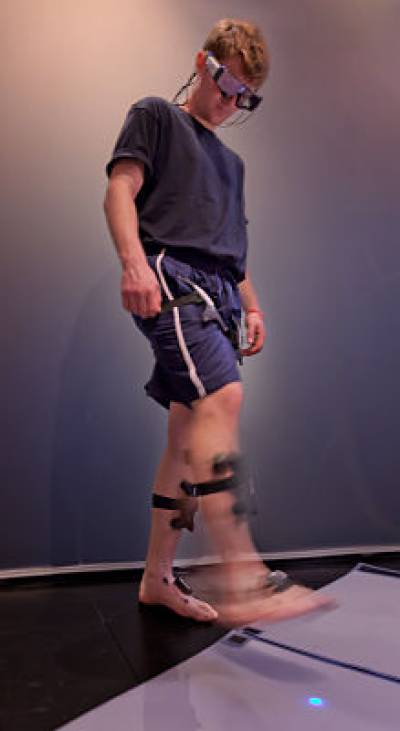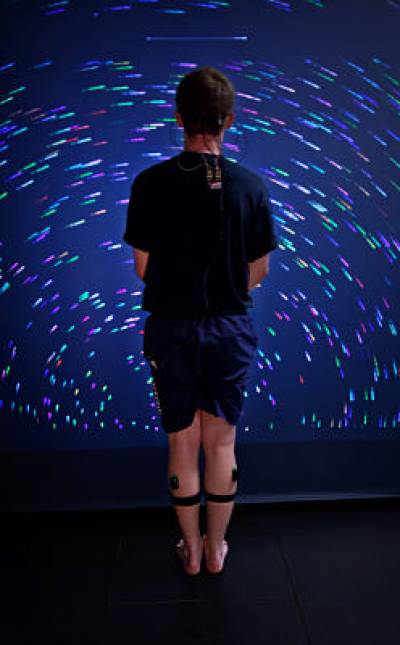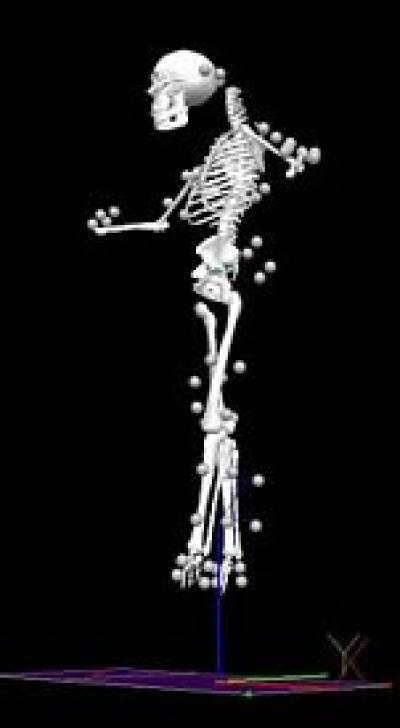Lab Head: Professor Brian Day
 |  |
About us
The laboratory focuses on neural processes that control human movement and balance, and their disorders resulting from damage to the central nervous system.
Our main lines of investigation are aimed at understanding the mechanisms that control and integrate whole-body actions, in particular standing, walking, and reaching. We are interested in how the neural processes combine sensory information from vestibular organs, eyes, muscles and skin to compute motor instructions. The brain regions in which we are currently interested include the cerebellum, basal ganglia, and parietal cortex.

The labs are housed on the 5th floor of 33 Queen Square.
The main research tools consist of non-invasive sensory stimulation techniques coupled with 3D movement measurement technology.
The recording equipment includes eight CODA sensor units each of which can determine the 3D coordinates of up to 56 infrared emitting body markers.
This kinematic information is combined with force data from up to five Kistler force plates and two JR3 6-axis force handles, electromyographic activity transmitted wirelessly from up to 32 muscles using a Delsys Trigno system, as well as gaze data from SMI Eye Tracking Glasses.
Trunk control projects
Sit-to-stand
Cacciatore, T.W., Mian, O.S., Peters, A., Day, B.L. (2014). Neuro-mechanical interference of posture on movement: evidence from Alexander technique teachers rising from a chair. Journal of Neurophysiology 112(3), 719-729
Cacciatore, T.W., Gurfinkel, V.S., Horak, F.B., Day, B.L. (2011). Prolonged weight-shift and altered spinal coordination during sit-to-stand in practitioners of the Alexander Technique. Gait and Posture 34(4), 496-501
Use of vestibular information for trunk movement
Day, B. L., Reynolds, R. F. (2005). Vestibular reafference shapes voluntary movement. Current Biology 15(15), 1390-1394
Cauquil, A. S., Day, B. L. (1998). Galvanic vestibular stimulation modulates voluntary movement of the human upper body. The Journal of Physiology 513(2), 611-619
Trunk control after stroke: Method for evaluating multidirectional trunk force control
Mockova, M., Greenwood, R., Day, B. L. (2006). A method for quantifying directional strength and motor control of the trunk. Journal of Neuroscience Methods 156(1-2), 211-217
Standing projects
Cerebellar ataxia
Bunn, L.M., Marsden J.F., Voyce, D.C., Giunti, P., Day, B.L. (2015). Sensorimotor processing for balance in spinocerebellar ataxia type 6. Movement Disorders. DOI: 10.1002/mds.26227
Bunn, L.M., Marsden J.F., Giunti, P., Day, B.L. (2015). Training balance with opto-kinetic stimuli in the home: a randomized controlled feasibility study in people with pure cerebellar disease. Clinical Rehabilitation 29(2), 143-53
Bunn, L.M., Marsden, J.F., Giunti, P., Day, B.L. (2013). Stance instability in spinocerebellar ataxia type 6. Movement Disorders 28(4), 510-516
Vestibular control of standing
Vestibular processes
Mian, O.S., Day, B.L., (2014). Violation of the craniocentricity principle for vestibular-evoked balance responses under conditions of anisotropic stability. The Journal of Neuroscience 34(22), 7696-7703
Day, B. L., Marsden, J. F., Ramsay, E., Mian, O. S., Fitzpatrick, R. C. (2010). Non-linear vector summation of left and right vestibular signals for human balance.. J Physiol 588(Pt 4), 671-682
Cathers, I., Day, B. L., Fitzpatrick, R. C. (2005). Otolith and canal reflexes in human standing. The Journal of Physiology 563(1), 229-234
Cognitive inputs
Guerraz, M., Day, B. L. (2005). Expectation and the vestibular control of balance. Journal of Cognitive Neuroscience 17(3), 463-469
Interaction with load
Marsden, J. F., Blakey, G., Day, B. L. (2003). Modulation of human vestibular-evoked postural responses by alterations in load. The Journal of Physiology 548(3), 949-953
Marsden, J. F., Castellote, J., Day, B. L. (2002). Bipedal distribution of human vestibular-evoked postural responses during asymmetrical standing. The Journal of Physiology 542(1), 323-331
Interaction with vision
Day, B. L., Guerraz, M. (2007). Feedforward versus feedback modulation of human vestibular-evoked balance responses by visual self-motion information. The Journal of Physiology 582(1), 153-161
Interaction with proprioception
Day, B. L., Cole, J. (2002). Vestibular-evoked postural responses in the absence of somatosensory information. Brain 125(9), 2081-2088
Impact of stroke
Marsden, J. F., Playford, E. D., Day, B. L. (2005). The vestibular control of balance after stroke. Journal of Neurology, Neurosurgery and Psychiatry 76(5), 670-678
Parkinson's disease
Pastor, M. A., Day, B. L., Marsden, C. D. (1993). Vestibular induced postural responses in Parkinson's disease. Brain 116, 1177-1190
Orthostatic tremor
Fung, V. S., Sauner, D., Day, B. L. (2001). A dissociation between subjective and objective unsteadiness in primary orthostatic tremor. Brain 124(2), 322-330
Other diseases
Abdel-Aziz, K., Schneider, T., Solanky, B.S., Yiannakas, M.C., Altmann, D.R., Wheeler-Kingshott, C.A.M., Peters, A.L., Day, B.L., Thompson, A.J., Ciccarelli, O. (2015). Evidence for early neurodegeneration in the cervical cord of patients with primary progressive multiple sclerosis. Brain pii: awv086
Welgampola, M.S., Ramsay, E., Gleeson, M.J., Day, B.L. (2013). Asymmetry of balance responses to monaural galvanic vestibular stimulation in subjects with vestibular schwannoma. Clinical Neurophysiology 124, 1835-1839
Upper limb projects
Parkinson's disease
Ling, H., Massey, L.A., Lees, A.J., Brown, P., Day, B.L. (2012). Hypokiesia without decrement distinguishes progressive supranuclear palsy from Parkinson's disease. Brain 135(4), 1141-1153
Ling, H., Petrovic, I., Day, B.L., Lees, A.J. (2012). Smoking-induced transient motor deterioration in a levodopa-treated patient with Parkinson's disease. Journal of Neurology 259(11), 2419-2423
Coordination
Roberts, R.E., Bain, P.G., Day, B.L., Husain, M. (2013). Individual differences in expert motor coordination associated with white matter microstructure in the cerebellum. Cerebral Cortex 23, 2282-2292
Perception
Luu, B.L., Day, B.L., Cole, J.D., Fitzpatrick, R.C. (2011). The fusimotor and reafferent origin of the sense of force and weight. Journal of Physiology 589(13), 3135-3147
Visual control of reaching
Subcortical and cortical routes
Day, B.L. (2014). Subcortical visuomotor control of human limb movement. Advances in Experimental Medicine and Biology 826, 55-68
Reynolds, R.F., Day, B.L. (2012). Direct visuomotor mapping for fast visually-evoked arm movements. Neuropsychologia 50, 3169-3173
Day, B. L., Brown, P. (2001). Evidence for subcortical involvement in the visual control of human reaching. Brain 124, 1832-1840
Day, B. L., Lyon, I. N. (2000). Voluntary modification of automatic arm movements evoked by motion of a visual target. Experimental Brain Research 130(2), 159-168
Cerebellar ataxia
Day, B. L., Thompson, P. D., Harding, A. E., Marsden, C. D. (1998). Influence of vision on upper limb reaching movements in patients with cerebellar ataxia. Brain 121, 357-372
Past group members:
- Mr. Matthew Bancroft
- Ms Amy Peters
 Close
Close

